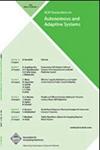利用公共交通规划城市区域应用
IF 2.2
4区 计算机科学
Q3 COMPUTER SCIENCE, ARTIFICIAL INTELLIGENCE
引用次数: 4
摘要
智能手机的发展催生了城市区域应用:通过公共(移动)基础设施(如公共汽车和有轨电车)在城市中进行通信的应用。在此设置中,应用程序需要使用在城市中移动并在它们之间传输数据的中介体相互通信和发现。这要求程序员将处理路由消息的代码分散到正确的位置,并在整个程序中处理网络故障。我们的方法允许程序员以高级方式指定城市区域的应用程序,而无需使用中介直接编码通信。我们将其作为从高级面向对象编程范式到低级通信机制的转换。这种转换允许程序员限制消息的路由,例如,限制一定数量的跳数、地理区域,甚至限制载波设备的类型。此外,我们还展示了如何在低级通信中有效地表示高级组消息传递。最后,我们记录了我们在建立小规模现实世界城市区域应用程序方面的经验。本文章由计算机程序翻译,如有差异,请以英文原文为准。
Programming Urban-Area Applications by Exploiting Public Transportation
The evolution of smartphones has given rise to urban-area applications: applications that communicate in a city by means of the public (moving) infrastructure (e.g., buses and trams). In this setting, applications need to communicate with and discover each other using intermediaries that move around the city and transfer data between them. This requires programmers to scatter code that deals with routing messages to the correct place and deal with network failures all over their programs. Our approach allows the programmer to specify urban-area applications in a high-level manner without the burden of directly encoding communication using intermediaries. We present this as a translation from a high-level object-oriented programming paradigm to a low-level communication mechanism. This translation allows the programmer to restrict routing of messages to, for example, a certain number of hops, geographic areas, or even types of carrier devices. In addition, we show how high-level group messaging can be efficiently represented in the low-level communication. Finally, we document our experiences in setting up a small-scale real-world urban-area application.
求助全文
通过发布文献求助,成功后即可免费获取论文全文。
去求助
来源期刊

ACM Transactions on Autonomous and Adaptive Systems
工程技术-计算机:理论方法
CiteScore
4.80
自引率
7.40%
发文量
9
审稿时长
>12 weeks
期刊介绍:
TAAS addresses research on autonomous and adaptive systems being undertaken by an increasingly interdisciplinary research community -- and provides a common platform under which this work can be published and disseminated. TAAS encourages contributions aimed at supporting the understanding, development, and control of such systems and of their behaviors.
TAAS addresses research on autonomous and adaptive systems being undertaken by an increasingly interdisciplinary research community - and provides a common platform under which this work can be published and disseminated. TAAS encourages contributions aimed at supporting the understanding, development, and control of such systems and of their behaviors. Contributions are expected to be based on sound and innovative theoretical models, algorithms, engineering and programming techniques, infrastructures and systems, or technological and application experiences.
 求助内容:
求助内容: 应助结果提醒方式:
应助结果提醒方式:


